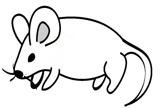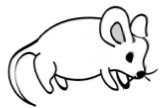Certain mice and voles have grown bigger brains over the last 100 years.
 In her new study, Anthropogenic Environments Exert Variable Selection on Cranial Capacity in Mammals, University of Minnesota biologist Emilie C. Snell-Rood offers a startling affirmation that where critters live may well cause the evolution of bigger brains. And smaller ones.
In her new study, Anthropogenic Environments Exert Variable Selection on Cranial Capacity in Mammals, University of Minnesota biologist Emilie C. Snell-Rood offers a startling affirmation that where critters live may well cause the evolution of bigger brains. And smaller ones.
Dr. Snell-Rood looked at a collection of mammal skulls collected as early as the beginning of the 20th Century by the University of Minnesota. She measured the dimensions of the skulls of ten species including mice, shrews, bats and gophers.
 The brains of the white-footed mouse and the meadow vole who had lived several generations in cities were some six percent bigger than the brains of animals collected from farms or wood. She concluded that their brains grew when these species moved to the bright lights and big city distractions.
The brains of the white-footed mouse and the meadow vole who had lived several generations in cities were some six percent bigger than the brains of animals collected from farms or wood. She concluded that their brains grew when these species moved to the bright lights and big city distractions.
Uh oh. Does that mean I would have gotten that Nobel by now had I just not stayed a country mouse?
Maybe it’s not just city life.
Evolutionary biologists recognize change is a formidable evolutionary force. Corn’s wild ancestor is teosinte, a grass with tassels. While grasses don’t look much like corn-on-the-cob, a single gene changed by a single kernel’s (almost) uninterrupted passage through a wolf brought about a longer cob in the next season. Likewise, bacteria have adapted to antibiotics in less than a century.
Dr. Snell-Rood found two species of shrews and two species of bats grew mo’ brains in rural Minnesota as well.
She proposes that the brains of all six species have gotten bigger because the radically disrupted environment allows only the animals better at learning to survive.
[Ed. Note: Neanderthal cranial capacity is now believed to have been larger than human skulls. Reconstructions of Neanderthal infants showed that Neanderthals and modern humans started with the same size skull but the Neanderthal brain outpaced the modern human brain by adulthood.]
The Minnesota study also found that the cranial capacity shrinks in species in environments that require no added learning to survive.
 A subsequent study at the Lightman Group looked at rattus norvegicus trained to hide food from their study group. The animal models developed an interesting added behavior: after the initial concealment, the animals studied distracted all the others in the environment away from the hiding place. In other words, they lied to their study group. After just three generations, cranial capacity in the entire cohort shrank by eight percent.
A subsequent study at the Lightman Group looked at rattus norvegicus trained to hide food from their study group. The animal models developed an interesting added behavior: after the initial concealment, the animals studied distracted all the others in the environment away from the hiding place. In other words, they lied to their study group. After just three generations, cranial capacity in the entire cohort shrank by eight percent.
Finally, a Smithsonian Institution study of groups of 535 people in Washington DC from 1900-2012 shows that brains have gotten 11 percent smaller in that sample.

It is worth noting that, aside from Dr. Snell-Rood’s initial measurements, this piece is an excellent example of Newspaper Science in which the author takes a single interesting fact and extrapolates unexpected conclusions. Of course, there is a lot of circumstantial evidence…
This provides a small feature to add to one of my completely unwritten science fiction novels (I have two, no, three).
Ahh, would that the US Congress were indeed science fiction.